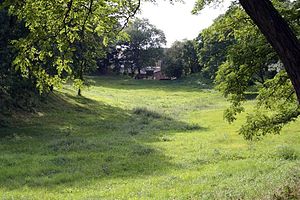Drense ramparts
| Drense ramparts | ||
|---|---|---|
|
Inner bailey |
||
| Creation time : | 7th to 8th centuries | |
| Castle type : | Niederungsburg | |
| Conservation status: | Burgstall | |
| Place: | Drense | |
| Geographical location | 53 ° 18 '32 " N , 13 ° 58' 46" E | |
|
|
||
The castle wall of Drense , a district of the municipality Grünow in the district of Uckermark , is the stables of a Slavic low castle , a Slavic castle wall from the 8th to 13th centuries.
description
The soil monument is located in the southern outskirts of the village. The castle wall has a west-east extension of 160 meters and a north-south extension of 135 meters. Its ground plan is almost horseshoe-shaped. The pure inner area of the castle is 2.3 hectares . In investigations by Volker Schmidt from 1980 to 1984 it was found that there was an unpaved Slavic village in the same place in the 6th and 7th centuries. Around 700 the construction of the castle complex began, which was expanded in the 9th century with a fortified outer bailey. During this time, the castle was the center of a 14 km² Old Slavic settlement chamber . In the course of the 9th and 10th centuries, according to the interpretation of the finds, there were some attacks on the castle, because several renovations of the main castle could be proven. Around the year 1000, two settlements emerged outside the castle complex, as well as later a body burial ground on a hillside. In the 11th and 12th centuries, the Slavs built the castle into an impressive fortress by repeatedly widening and raising the ramparts. In the opinion of Volker Schmidt, the castle was one of the main Ukranian castles at the time . The castle residents cultivated extensive trade relations with the Kievan Rus , Poland, Moravia and the Baltic region. In the outer bailey potters, traders and craftsmen worked in bronze jewelry. Around 1150 there was a devastating attack on the castle complex, which can be seen in connection with Albrecht the Bear's conquest of the Slavs in today's Brandenburg. The wall of the main castle was razed and replaced by a simpler wooden structure. The castle was now under German sovereignty and was mentioned in documents in 1240, 1243 and 1248. A little later the castle complex was finally given up.
literature
- Volker Schmidt : Drense, a main castle of the Ukrane. German Science Publishing House, 1989
- Felix Biermann : The castle wall of Drense (Uckermark) and its central functions in the Slav period. In: Felix Biermann, Th. Kersting, A. Klammt (Ed.): Religion and Society in the Northern West Slavonic Area. Contribution Ur- u. Early History of Central Europe 82, Langenweißbach, 2017, pp. 245–269.
Web links
Individual proof
- ↑ Page no longer available , search in web archives: The Drense castle wall in the digital terrain model: Brandenburg viewer (longer loading time!)

